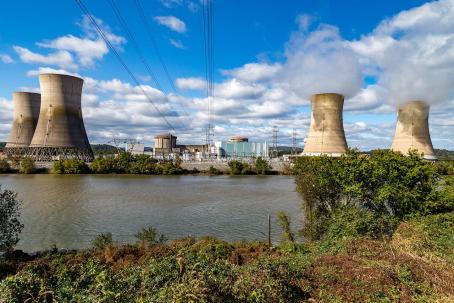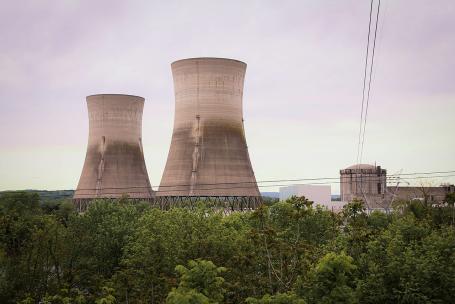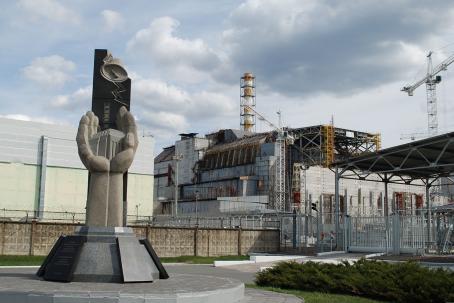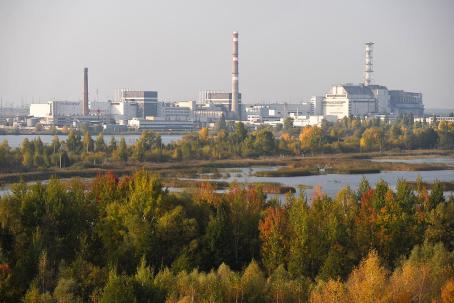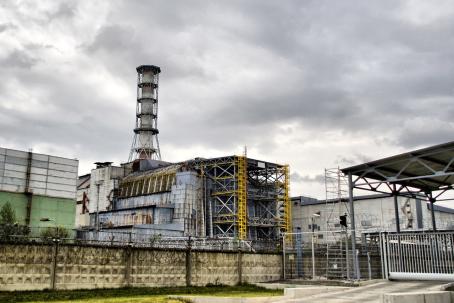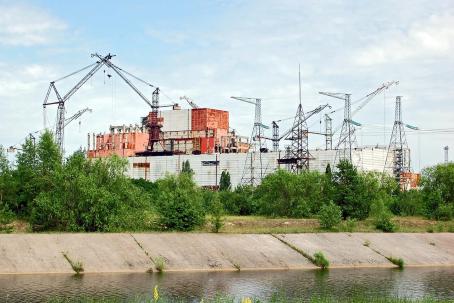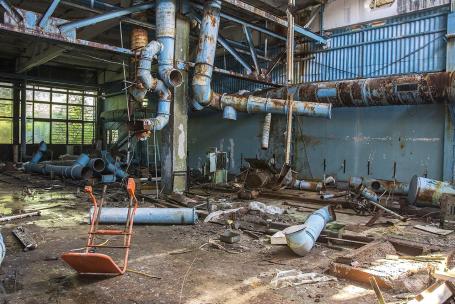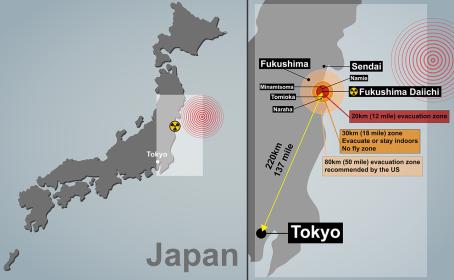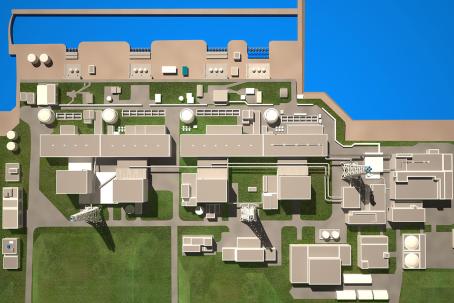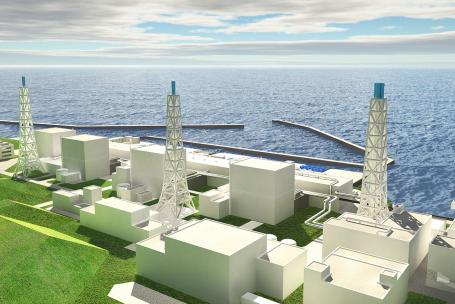
Nuclear Accidents
19 min read
Every industry or energy sector is subject to accidents. The nuclear energy industry is no exception, but serious accidents have been very scarce. Globally, the nuclear reactors as a whole have been operating in excess of 15,000 reactor-years and during this period there have been only three serious accidents and only one had human causalities. Namely, the following accidents: the American nuclear power plant Three Mile Island (1979), the Ukrainian Chernobyl (1986), and the Japanese Fukushima Daiichi (2011).
Three Mile Island
The Three Mile Island nuclear power plant was named after the island situated three miles downstream on the Susquehanna River near Middletown, Pennsylvania, USA.
The Three Mile Island nuclear power plant is located near Harrisburg, Pennsylvania, USA. There are two blocks with pressurized-water reactors, PWR. The first block, TMI 1, was commissioned in 1974 and delivers 800 MW of electricity to the grid. It is one of the best reactors in the USA, with a minimum number of shutdowns. The second block, TMI 2, with a power output of 906 MW, was commissioned in 1979 and three months later there was a serious accident, and it was shut down, permanently.
The accident began at 4 a.m. on March 28, 1979. A small failure in the secondary circuit resulted in a temperature increase in the primary circuit. The automatic safety systems dropped the shutoff rods into the core, resulting in reactor shutdown. For effective cooling of the shutdown reactor, the cooling water pressure was automatically reduced using a relief valve that was supposed to immediately close. However, the valve was stuck open and the cooling water started to escape from the reactor core. Due to the resulting pressure drop, the pumps started to deliver more water into the primary circuit. However, the mixture of water and steam continued to escape through the stuck valve into the pressurizer, raising its level. The pressurizer maintains a constant pressure in the primary circuit (it contains a mixture of water and steam). The pressurizer cannot fulfill its function if it is full of water. However, the plant operators did not have any other information about the water level inside the reactor except the pressurized level. Moreover, they thought the relief valve was closed. This led to the wrong conclusion that there was too much water in the primary circuit and the operators tried to release it. This actually helped start the accident. Since the fuel rods were partially exposed from the cooling water, about one-third of the fuel had melted down. The released cooling water contaminated by the fission products was later automatically re-pumped into a tank in the auxiliary building outside of the containment boundary and, through a ventilation stack, radioactive gas was released into the atmosphere. The reactor was stabilized in a few days and there was no additional release of any radioactive material.
Night view of the first block’s cooling towers at the Three Mile Island nuclear power plant, USA. The accident at TMI 2 resulted in the establishment of WANO, The World Association of Nuclear Operators. This association helps to improve safety by organizing international inspection missions and by sharing examples of good practices used for nuclear power plant operation.
This accident was classified on the INES scale as level 5. The cause was several minor faults happening concurrently, but primarily it was the human error made by the plant operators. Based on operator training and insufficient information on the reactor state, the operators did not correctly diagnose the problem and their actions only made the accident worse. The reactor safety systems functioned correctly; the only serious breach of safety was the re-pumping of radioactive water outside of the containment boundary.
The radioactive material released posed no serious danger to the immediate environment or to the inhabitants of nearby Harrisburg. Very little radiological contamination was reported; the public in the vicinity of the plant received at most 1 mSv, and in most cases much less (0.08 mSv). The medical condition of 32,000 people living near the plant was regularly monitored for 13 years and no medical problems were reported.
For a certain period, the power plant operators tried to hide the accident and its impact. Due to insufficient communication and many misunderstandings, a panic, helped by sensation-hungry media, resulted. No forced evacuation was declared, but many people left the area around the power plant in panic. The movie The China Syndrome describing a nuclear power plant accident, that had premiered only 12 days before the accident, probably played a role in creating the mass hysteria.
It took 12 years and 973 million USD to rectify the accident, more than a new reactor would cost. TMI 2 has never been commissioned. An analysis of the causes of the accident led to strengthening the safety regulations and more emphasis was put on nuclear power plant operator training.
It took several months to realize that part of the reactor core of the Three Mile Island power plant had melted down.
Chernobyl
The Chernobyl nuclear power plant. The memorial to the individuals who helped, without any special tools, to clean up the accident and thus helped to “save the world”. The memorial is located about 100 meters from the destroyed block 4.
The Ukrainian nuclear power plant Chernobyl is located 130 kilometers from Kiev and 20 kilometers from the Belorussian border. There are four RBMK 1000 type reactors, commissioned in 1970–1983. There were two additional blocks under construction when block four was devastated by disaster. These blocks were never completed. The remaining three blocks were modernized and operated until 2000. The town nearest to the power plant is Pripyat. At the time of the accident, there were 49,000 inhabitants, and it is now deserted. The village Chernobyl, that gave the power plant its name, is 15 kilometers away.
The disaster began at night on April 26, 1986 after a series of wrongful and irresponsible actions performed during the previous day. Prior to a routine reactor shutdown, a test to see how long a rundown turbine can still generate electricity (in the case of loss of external power) to power the main pump of the primary cooling circuit. To be able to carry out this experiment, the plant operators disabled the reactor emergency cooling system. The reactor power output ramp-down was initiated, but the experiment was interrupted for several hours as requested by the grid operator since more electricity was required.
Pripyat, the nearest town to the destroyed Chernobyl block 4, was evacuated with a one-day delay. It has been deserted for more than 25 years and is part of the so-called dead zone.
The actual experiment was initiated late at night. After midnight, the power output dropped down to only 30 MWt. due to an operator error, and the reactor became unstable. The operators attempted to increase the power output and withdrew most of the control rods from the reactor core. The regulations stipulated at least 15 inserted rods, at the time of the accident there were only 8 rods inserted in the core. A reactor at low power suffers from xenon poisoning — the accumulation of xenon, an effective neutron absorber. However, xenon is promptly burned up during a quick power increase of the fission reaction, and thus contributed to a steep power output increase.
Finally, the plant operators stabilized the reactor power output at 200 MWt and initiated the experiment. The electric pumps were supplied by the generator driven by a turbine running down, the flow of coolant water decreased somewhat, and warmer water entered the lower portion of the reactor and started to boil. At that moment, for reasons unknown, an instruction was given for an emergency reactor shutdown (scram) and the graphite tops of the inserted shutoff rods also led to the local increase of the fission reaction. The positive void coefficient, an inherent property of all BRMK reactors, in conjunction with the fast loss of xenon, caused a quick increase in reactor power and the coolant water started to boil. The generated steam pressure lifted the 1,000-ton concrete slab placed above the reactor, which came crashing down, destroying the cooling pipes as well as the control rods. Moments later, there was a second explosion — hydrogen was generated and exploded. A portion of the reactor core was torn by the explosion, throwing out hot graphite debris that ignited the asphalt roof of the building.
The huge concrete sarcophagus of block 4 was constructed a few months after the accident in order to prevent any additional release of radioactive substances into the atmosphere. This sarcophagus is already near its service-life end and its replacement is being designed.
After the accident, the reactor was cooled by water and from helicopters was covered by tons of sand, lead, dolomite, and boron. It took 10 days to extinguish the fire and for this entire time radioactive material was being released into the environment from the breached reactor core. The majority of the radioactive debris remained near the reactor; the rest (mostly iodine and cesium) was carried by wind throughout Europe. The total released radioactivity was about 14 × 1018 Bq, representing about 5% of all the radioactive material contained in the reactor before the accident. Approximately 300 tons of hot graphite and uranium were blown into the environment. In the end, using remotely controlled machines, a concrete sarcophagus was constructed above the reactor. However, it requires permanent maintenance, and construction of a new envelope is anticipated.
At the time of the Chernobyl nuclear power plant accident, there were two more blocks with the same reactor, block 5 and 6, under construction. Due to safety concerns, these blocks were never completed.
The Chernobyl accident was classified as INES level 7: the most serious accident in the history of the nuclear reactor. This accident was caused by a series of serious operator errors, insufficient operator training and know-how, as well as gross breach of safety regulations. An inept reactor design also played its part.
In total, 600,000 people participated in the cleanup of this accident: 600 of them, summoned immediately after the accident, were exposed to a high radiation dosage. 237 individuals were diagnosed as suffering acute radiation sickness, of which 28 individuals died. Additionally, two people died during the explosion and another individual suffered a fatal heart attack as a direct result of these events.
The ruins of industrial and commercial buildings in the deserted town of Pripyat remind us of a ghost town. Dilapidated buildings are taken over by Nature.
The radioactivity released caused a greater incidence of thyroid gland cancer in children, including a few fatal cases. For the rest of the population, no significant increase of cancer incidence has been detected.
Evacuation of the nearby Pripyat was delayed by one day; the evacuation zone was later extended to a 30 km diameter circle. In total, 300,000 people were evacuated from the Chernobyl area. Information about the accident, its extent and possible effects were lacking; for many days, most of Europe was unaware of what had happened. The ensuing panic and hysteria exaggerated the gravity of the accident; setting very strict limits regarding the content of radionuclides in foodstuff and in other goods has increased the cost many times, not withstanding the very negative public perception of the nuclear power industry. All RBMK type power plants were subsequently modernized, so that the effect of the positive void coefficient is eliminated, and also the operators are prevented from breaching safety regulations.
The design of the Chernobyl reactor was so problematic that a breach of just three fuel channels resulted in the destruction of the entire reactor.
Fukushima
Earthquake epicenter, location of the Fukushima nuclear power plant, the nearest towns and the three evacuation zones are depicted on a map of Japan.
All Japanese power plants are constructed on the seacoast, because they use seawater for cooling. The Fukushima Daiichi nuclear power plant is located on Honshu Island, 90 km from Sendai. There are six boiling water reactors (BWR), commissioned in 1971—1979. Since it is located on the seacoast, there is the danger of a tsunami. A system of dykes was constructed to protect the plant against a wave about 7 meters high. On March 11, 2011, an earthquake followed by a tsunami, with about 30,000 dead and missing persons, was bigger than the plant designers had expected.
On March 11, 2011 there was a very strong earthquake located 130 kilometers from the coast of Japan. This is referred to as the “Great East Japan Earthquake” (Also called the Tohoku Earthquake), classified as 9 on the Richter scale. At the time of the earthquake, the nuclear reactors were shutdown automatically by their shutoff rods. At Fukushima, this concerned reactor 1, 2, and 3, the other reactors were already in cold shutdown for planned maintenance. The quake itself did not cause any damage to the plant. Because the grid was down, the emergency generators came online to power the electronics and the coolant systems, since a shutdown reactor still generates lots of heat.
Model cross section of the boiling water reactor used in the Fukushima Daiichi nuclear power plant blocks.
Video: Model of a boiling water reactor operated in the damaged blocks of the Fukushima nuclear power plant.
However, one hour later, the tsunami, at least 14 meters high, had reached the coast. Water went over the dykes and flooded the machine room, damaged the cooling piping leading to the sea, destroyed the fuel tanks for the diesel generators, and also flooded some standby batteries: the power plant lost almost all of its power supply. Without cooling, the reactors, still generating about 30 MW, started to overheat. For a short while, some blocks still had the emergency cooling running since it can function with a DC battery supply, but it also eventually failed. It took 8 hours to bring spare power supplies to partially restore cooling. However, it was not possible to effectively remove all the generated heat, because the cooling circuit was damaged by the tsunami. The cooling water started to boil in the reactors, generating steam, and the exposed fuel rods melted.
At this point, the plant operators decided that only a prompt flooding of the reactors with seawater could have cooled the reactor. To do that, the reactor pressure had to be reduced and part of the steam was vented into the atmosphere. Radioactive material was released and most importantly, a reaction between the nuclear fuel zircalloy cladding and the steam produced hydrogen, which exploded and damaged the roofs of all the reactor blocks. The actual power plant containment remained intact. Block 4 was also damaged; the water level in the pool used to store spent fuel decreased and there was also a hydrogen-air explosion.
Model of the Fukushima nuclear power plant that suffered a great disaster in March 2011. A tsunami wave flooded the machine room, damaged the tanks for diesel generators, leaving the power plant without electricity.
The struggle to stabilize the reactors continued until the end of 2011: radioactivity was released into the atmosphere and coastal waters several times. The total amount of radioactivity released from the power plant was about 770 × 1015 Bq, primarily iodine and cesium.
The Fukushima power plant’s surrounding area was gradually evacuated, the evacuation radius was extended to 20 km. None of the local inhabitants were injured or exposed to a dangerous dose of radiation. A few of the plant’s employees who were present during the accident were exposed to a higher dose of radiation: two received a dose of about 500 mSv, the international limit for workers participating in rescue operations. No radiation sickness was recorded, but two workers who waded through radioactive water suffered beta-burns of their skin. However, they were cured without any lasting effects. A few people in the facility were injured or killed by the tsunami or by falling debris.
Spatial model of the buildings and equipment of the Japanese Fukushima nuclear power plant that was damaged by a large tsunami wave. The system of protective dykes was insufficient and the second largest nuclear accident in the world resulted.
This accident was assessed as the highest level 7 on the INES scale, despite the fact that the effects were actually much smaller than those of the Chernobyl accident assessed at the same level 7. The accident investigation is still ongoing and thus it is too early to say whether there was a wrong decision made or action taken that made the situation worse, but it clearly was the first serious disaster in history of the nuclear power industry caused by natural forces, and it is also clear that the people and the technology tried to minimize the effects of this catastrophe as much as possible.
The accident has generated a new wave of distrust in the nuclear power industry. Many countries were forced to reevaluate their attitudes towards nuclear energy, to carry out additional tests of their nuclear power plants to make sure that they can withstand similar natural disasters, or even temporarily close their nuclear power plants (as in Germany).



